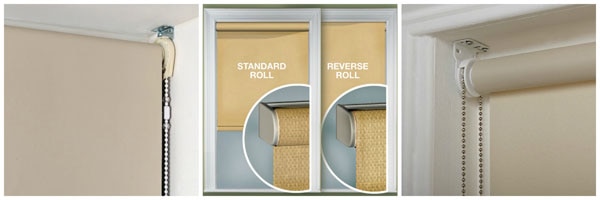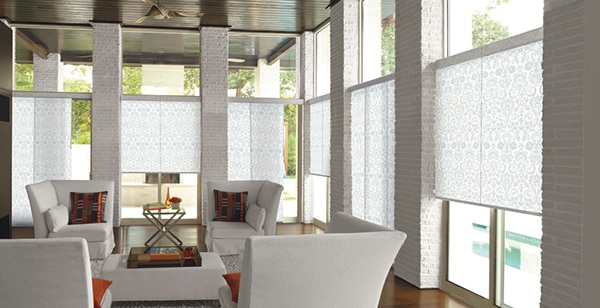If you want to roll with us, you’re going to need to know a thing or two about roller shades. Most importantly, I’m talking about reverse and standard rolls – the two ways you can hang the fabric from the top of your shade.
With a standard roll, your fabric will lay flat against your window and raise up onto the top bar from behind when the shade is raised. This may cause the top fabric roll to stick out further from your window, but it also will create better light coverage.
Your other option is called a reverse roll. With this style, the shade fabric will wrap over the top roll and hang in front of your window like a waterfall. As you might imagine, this will create a bigger light gap, because the fabric isn’t technically touching your window, but you’ll get a cleaner, designer look. Whichever style you choose, your roller shades will effortlessly glide up and down your window.
Shop a huge selection of custom roller shades at Blindsgalore

What is Reverse Roll?
A reverse roll roller shade features fabric that rolls off the front of the tube, creating a distinctive “waterfall” effect. In this configuration, the shade fabric wraps over the top roll and cascades down in front of your window, positioning the material further away from the glass. This design choice offers several key advantages:
- Conceals hardware: The fabric hides the roller tube and mounting hardware, creating a clean, minimalist appearance
- Clears obstacles: Perfect for windows with handles, cranks, or trim that might interfere with the shade
- Designer aesthetic: Provides a sleek, contemporary look without requiring a separate valance
- Windowsill clearance: Allows space for decorative items or plants on your windowsill
What is Standard Roll?
Standard roll roller shades, also known as regular roll or traditional roll shades, have the fabric rolling off the back of the tube. This is the most common installation method where the fabric hangs closer to the window glass. Key characteristics include:
- Maximum light control: The fabric sits closer to the window, minimizing light gaps around the edges
- Better privacy: Reduces potential sight lines from outside
- Energy efficiency: Creates better thermal insulation by sealing closer to the window
- Exposed hardware: The roller tube and mounting mechanism remain visible
Difference Between A Reverse And A Standard Roll
| Feature | Standard Roll | Reverse Roll |
| Fabric Position | Rolls off back of tube, closer to window | Rolls off front of tube, away from window |
| Light Control | Superior light blocking, minimal gaps | More light leakage due to larger gaps |
| Hardware Visibility | Roller tube and hardware exposed | Hardware concealed behind fabric |
| Obstacle Clearance | May conflict with window handles/cranks | Clears protruding handles and trim |
| Aesthetic Appeal | Traditional look, may need valance | Clean, designer appearance without valance |
| Privacy | Better privacy due to tighter window fit | Slightly reduced privacy from larger gaps |
| Installation Frequency | Most common, industry standard | Less common, usually by specific request |
| Energy Efficiency | Better thermal performance | Reduced insulation due to air gap |
Standard vs reverse roller blinds ultimately comes down to your priorities: choose standard roll for maximum light control and privacy, or reverse roll for aesthetic appeal and obstacle clearance.
FAQs
Converting a standard roll to reverse roll is straightforward and can be done at home:
1. Remove the blind from its brackets and take down completely
2. Detach components: Remove the chain drive and idle end pieces
3. Unroll fabric: Roll up the fabric until only about 300mm remains
4. Remove fabric: Carefully pull the fabric off the roller tube
5. Flip the tube: Rotate the roller tube 180 degrees
6. Reattach fabric: Secure the fabric to the opposite side of the tube using the spline line
7. Reinstall: Replace the chain drive, idle end, and rehang the blind
8. Test tracking: Ensure the blind rolls straight; adjust with double-sided tape if needed
Yes, you can reverse a roller blind from standard to reverse roll or vice versa. The process involves flipping the roller tube so the fabric hangs from the opposite side. This modification is:
– Easily reversible: You can switch back if you don’t like the result
– No new parts needed: Uses existing components in a different configuration
– DIY-friendly: Most homeowners can complete this in under 30 minutes
– Risk-free: If installed incorrectly, simply flip it back to the original position
Reversing vertical blinds to change which side they stack on requires a different approach than roller blinds:
1. Open blinds completely so all slats stack to one side
2. Remove the valance covering the headrail by gently pulling the clips
3. Detach headrail: Pull the bottom of the headrail out of the retaining clips
4. Rotate 180 degrees: Turn the entire blind assembly around so the front becomes the back
5. Reinstall: Slide the headrail back into the clips, pushing the top in first then rotating down
6. Replace valance: Snap the cover back into place
7. Test operation: Verify the blinds slide smoothly in the new direction
Note that while you can change the stacking direction, the control position typically cannot be moved without professional modification.

